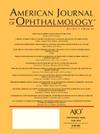中间葡萄膜炎中的蕨类视网膜血管病变:发病机制、自然史和临床意义。
IF 4.1
1区 医学
Q1 OPHTHALMOLOGY
引用次数: 0
摘要
目的探讨以蕨类渗漏为特征的中度葡萄膜炎患者外周血管病变及其进展,并探讨其与黄斑血管病变的关系,以阐明其发病机制、自然历史和临床意义。设计:以健康眼睛为对照的回顾性、观察性病例系列。43只眼(28例患者)患有中度葡萄膜炎(平均年龄31±16岁,58%为女性),与41只健康对照眼相比,随访时间平均为18个月。方法对超宽视场荧光素血管造影(UWF-FA)图像进行分析。采用线性混合效应模型比较不同渗漏程度(后极/弥漫性[1区]、中外围[2区]和远外围[3区])和对照眼的血管长度密度(VLD)、分形维数(FD)和分枝点密度(BPD)。手工追踪中央凹无血管区(FAZ)。平均结果测量:视网膜的定性变化和VLD、FD和BPD在三个同心的颞视网膜区域的定量测量。结果早期UWF-FA显示了研究眼睛的实质性改变,包括毛细血管通道扩张,毛细血管分支减少,静脉充盈延迟,毛细血管扩张后毛细血管扩张,主要发生在非灌注区域。中度葡萄膜炎患者的VLD、FD和BPD明显低于对照组,尤其是远周视网膜,弥漫性渗漏[1区]的降低最为明显(相互作用p值:VLD为0.04,FD为0.007,BPD为0.045)。这些血管指标与FAZ面积增大呈负相关,提示外周和黄斑灌注之间存在潜在关联(均p < 0.05)。尽管免疫抑制,蕨类渗漏仍持续存在,但强度降低;一些血管变化进展,而其他的,如非灌注和新生血管,显示可能的可逆性。结论:本研究确定了“蕨类视网膜血管病变”是一种独特的血管模式,至少在某些形式的中度葡萄膜炎中观察到,其特征是慢性血管重塑。认识到这些周围血管的改变在临床上很重要,因为在实践中强调这些模式可以改进治疗策略,减少不必要的长期免疫抑制,并改善受这种疾病影响的年轻人的管理。本文章由计算机程序翻译,如有差异,请以英文原文为准。
Fern-Like Retinal Vasculopathy in Intermediate Uveitis: Pathogenesis, Natural History, and Clinical Implications.
PURPOSE
To investigate peripheral vascular changes and their progression in intermediate uveitis characterized by a fern-like leakage pattern and examine their relationship with macular vascular changes to elucidate their pathogenesis, natural history, and clinical implications.
DESIGN
Retrospective, observational case series with healthy-eyes comparison.
PARTICIPANTS
43 eyes (28 patients) with intermediate uveitis (mean age 31±16 years, 58% female) followed for an average of 18 months, compared with 41 healthy control eyes.
METHODS
Ultra-widefield fluorescein angiography (UWF-FA) images were analyzed. Vessel Length Density (VLD), Fractal Dimension (FD), and Branchpoints Density (BPD) were compared across different leakage extents (posterior pole/diffuse[Zone 1], mid-periphery[Zone 2], and far periphery[Zone 3]) and control eyes using linear mixed-effects models. The foveal avascular zone (FAZ) was manually traced.
MEAN OUTCOME MEASURES
Qualitative retinal changes and quantitative measures of VLD, FD, and BPD across three concentric temporal retina sectors.
RESULTS
Early-phase UWF-FA revealed substantial alterations in study eyes, including dilated capillary channels, reduced capillary branching, delayed venous filling, and telangiectatic post-capillary dilations, primarily in non-perfused regions. Eyes with intermediate uveitis showed significantly lower VLD, FD, and BPD than controls, particularly in the far peripheral retina, with the most pronounced reductions in eyes with diffuse leakage [Zone 1](interaction p-values: 0.04 for VLD, 0.007 for FD, and 0.045 for BPD). Negative correlations were observed between these vascular metrics and enlarged FAZ areas, suggesting a potential association between peripheral and macular perfusion (all p < 0.05). Fern-like leakage persisted with reduced intensity despite immunosuppression; some vascular changes progressed, while others, such as non-perfusion and neovascularization, showed possible reversibility.
CONCLUSION
This study identifies "Fern-Like Retinal Vasculopathy" as a distinctive vascular pattern observed in at least some forms of intermediate uveitis, characterized by chronic vascular remodeling. Recognizing these peripheral vascular changes is clinically important, as emphasizing such patterns in practice may refine treatment strategies, reduce unnecessary long-term immunosuppression, and improve the management of young adults affected by this condition.
求助全文
通过发布文献求助,成功后即可免费获取论文全文。
去求助
来源期刊
CiteScore
9.20
自引率
7.10%
发文量
406
审稿时长
36 days
期刊介绍:
The American Journal of Ophthalmology is a peer-reviewed, scientific publication that welcomes the submission of original, previously unpublished manuscripts directed to ophthalmologists and visual science specialists describing clinical investigations, clinical observations, and clinically relevant laboratory investigations. Published monthly since 1884, the full text of the American Journal of Ophthalmology and supplementary material are also presented online at www.AJO.com and on ScienceDirect.
The American Journal of Ophthalmology publishes Full-Length Articles, Perspectives, Editorials, Correspondences, Books Reports and Announcements. Brief Reports and Case Reports are no longer published. We recommend submitting Brief Reports and Case Reports to our companion publication, the American Journal of Ophthalmology Case Reports.
Manuscripts are accepted with the understanding that they have not been and will not be published elsewhere substantially in any format, and that there are no ethical problems with the content or data collection. Authors may be requested to produce the data upon which the manuscript is based and to answer expeditiously any questions about the manuscript or its authors.

 求助内容:
求助内容: 应助结果提醒方式:
应助结果提醒方式:


